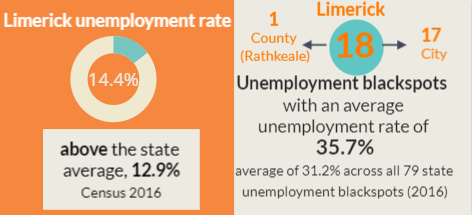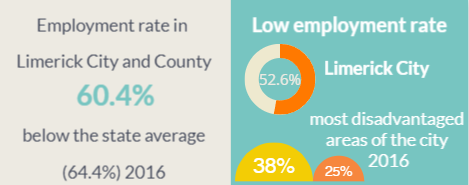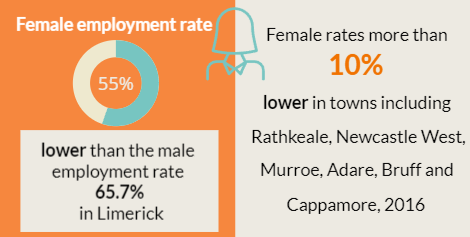2.9 Labour Market
The health of the local labour market can be measured in different ways including labour market participation, unemployment rates and the employment rate (the percentage of the working age population at work).
Unemployment
The unemployment rate for the state in July 2022 was 4.2%, a decrease compared with June 2022 and down compared with June 2021 (6.3%). The unemployment rate for the Mid-West Region in Quarter 1 2022 is 4.3%. These are amongst the lowest rates ever recorded.

Up-to-date local data on unemployment are not available from existing data sources. We can expect that the Limerick labour market follows the national trend (unemployment going downwards and now at a low level). However, we can also expect that the local labour market continues to display some challenges that are in evidence for a long time.
Going back to 2016 and using a different approach to measurement of unemployment as applied in the Census, the unemployment rate in Limerick City and County in 2016 (latest data) was 14.4% compared with a national average of 12.9%.[1]
Unemployment blackspots
There is a problem of structural unemployment in certain neighbourhoods within Limerick City. Census 2016 identified 79 unemployment blackspots across the State, where unemployment is two to three times the national average. Limerick City and County has the largest number of unemployment blackspots (18). It also has the highest average unemployment rate across these blackspots (average of 35.7% for Limerick blackspots compared with 31.2% across all 79 blackspots in the state). With one exception (Rathkeale, County Limerick) all unemployment blackspots in Limerick are in the city. The areas include all of the regeneration communities and other adjacent disadvantaged communities. Limerick City in 2016 accounted for eight out the 10 Electoral Divisions with the highest unemployment rates in the state. Economic growth in itself and an increase in the number of local job opportunities have not proved sufficient to change the pattern of high unemployment in these areas.

Much of the county or rural Limerick had unemployment rates below the state average (2016). Areas with higher unemployment rates were in the western part (including Abbeyfeale and pockets in Newcastle West) and in areas along the Estuary particularly Askeaton.
The Employment Rate
The employment rate – the percentage of the working age population (15-64 years) at work - is an important indicator of the health of the economy. This has been increasing steadily since the end of the Great Recession and, in the state as a whole, there has never been more people in work. The employment rate for the state as a whole in Q2 2021 was 68.6%, 73.4% for males and 63.9% for females.

Similar to unemployment data, there are no up-to-date data available at local level on the numbers of people in work. Latest local data on this indicator are based on Census 2016. In 2016, the employment rate for Limerick City and County was 60.4%, and below the state average of 64.4%. The employment rate for Limerick City was particularly low at 52.6% (56.4% for males and 48.8% for females), again a reflection of the serious structural employment problems across the city’s deprived communities. In the most disadvantaged areas, the regeneration areas, the employment rate was between 25% and 38%. In these areas, larger numbers of people of working age are unemployed, not working due to illness or disability or are economically inactive.
In the former Limerick County, the employment rate in 2016 was 63.8% just below the national average at the time, with a rate of 69.8% for males and 57.7% for females. Some rural areas had very high employment rates, especially for males.

In all settlements in Limerick County, the female employment rate is lower than the male employment rate. However, the gap between males and females varies. The gap between male and female employment rates is 10% and greater in favour of males in the towns of Newcastle West, Rathkeale, Murroe, Adare, Bruff and Cappamore and significantly lower in Croom, Hospital and Askeaton. The greatest difference is in Rathkeale where the male employment rate is 60.7% compared with a female rate of 35.4% (a gap of 25 percentage points).
Scope to Increase Labour Supply?
Labour supply is a key determinant of future economic growth for the city and the county. There is considerable unrealised potential within the working age population in the city and in the female population of working age. This highlights the scope to increase economic activity by expanding work opportunities for women and increasing the employment rate of females. It is also important to increase economic activity by building the human capital (education and skills) targeting disadvantaged areas in the city and other disadvantaged groups that show high rates of unemployment and economic inactivity (disabled people, Travellers, migrants coming out of Direct Provision). Specific interventions are needed to support people of working age in most disadvantaged groups into employment.
[1] This measure of unemployment is based on self-identified “principal economic status” in the Census. The measure returns a higher rate that the official unemployment rate, based on the ILO measure. The lowest level at which the official unemployment rates are recorded routinely (on a quarterly basis) is the Regional Level.